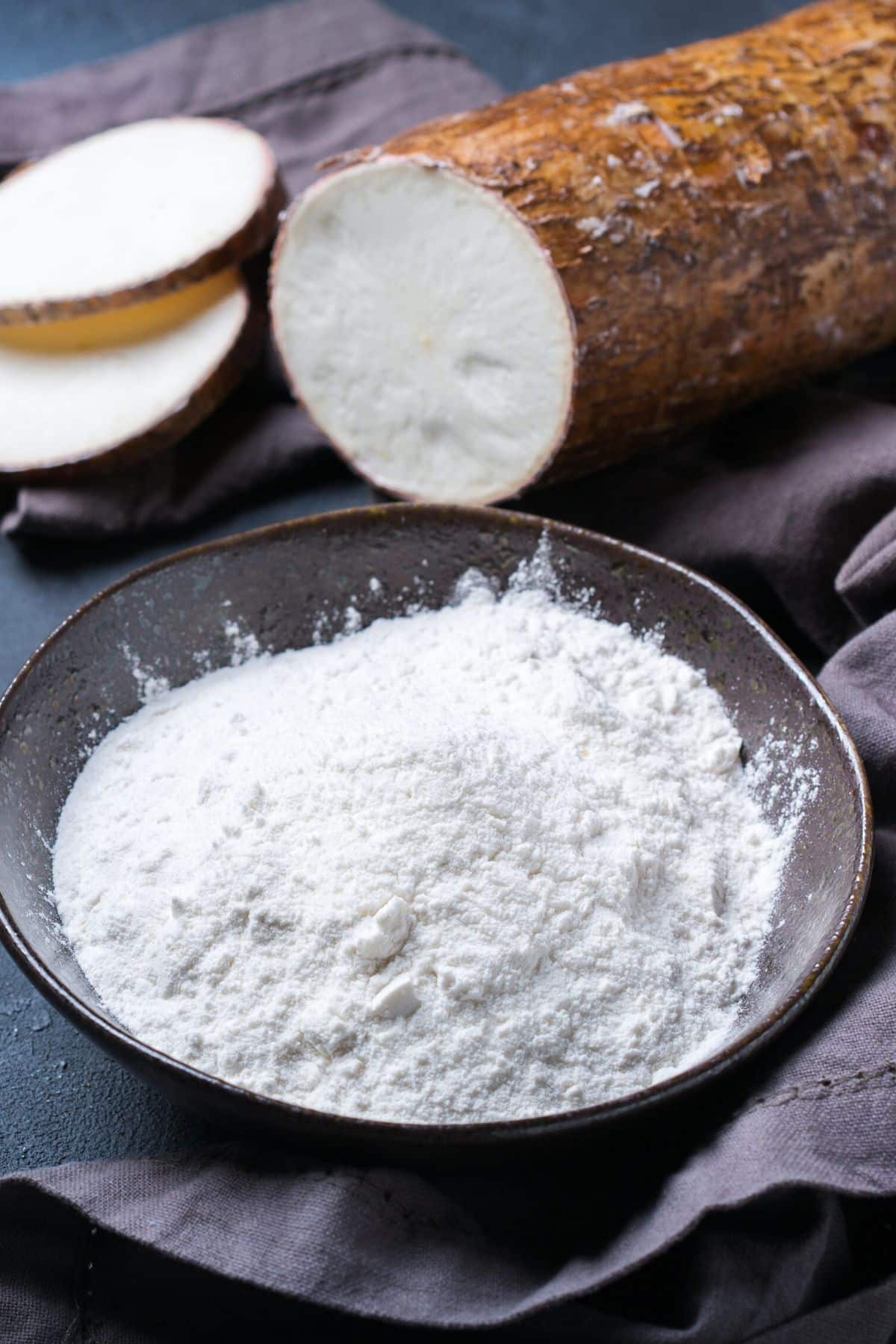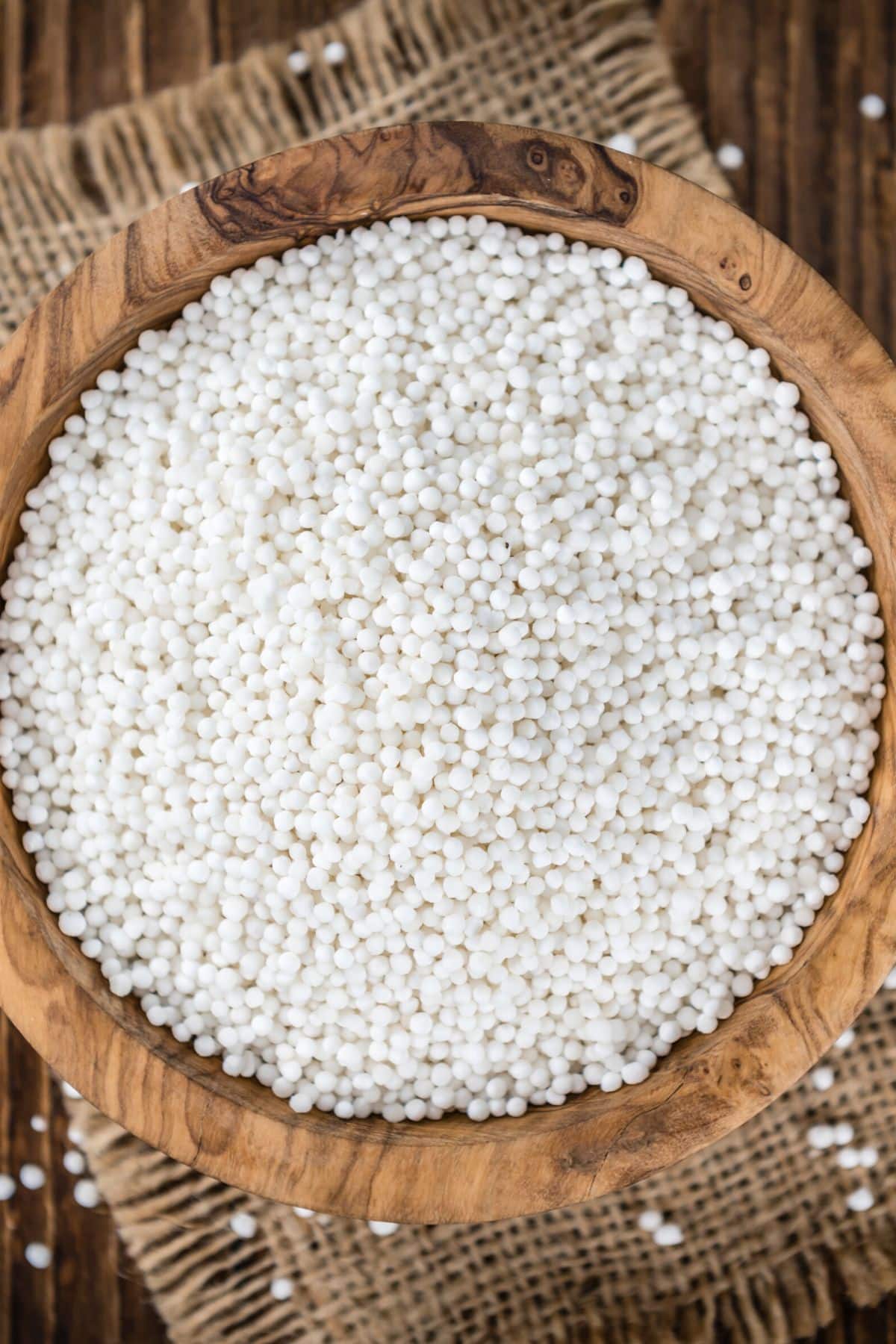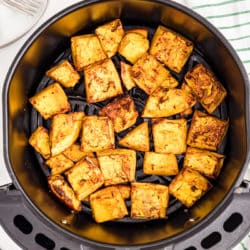Cassava Vs. Tapioca Flour
Cassava and tapioca flours are popular ingredients, especially in the gluten-free world. But what are the differences and similarities between these two products? Find out everything you need to know about cassava versus tapioca flour.

Overview of Cassava Flour
Also known as manioc, cassava is a starchy tuber and one of the world’s most versatile vegetables. Originally from tropical regions in South America, cassava was introduced to Africa by Portuguese explorers in the 1500s and later made its way to Asia.
These days, it feeds millions worldwide who enjoy its versatility and nutritional benefits. Cassava can be boiled, mashed, fried, or turned into flour and is rich in carbohydrates, calcium, vitamins, and minerals.
It’s also high in dietary fiber, which is great for gluten-free baking. Gluten-free baking enthusiasts will be happy to hear that cassava flour helps with binding and drastically improves the texture of baked goods. I love making Cassava Muffins, Cassava Pizza Crust, and Cassava Cookies!
Cassava flour is becoming an increasingly popular option for vegan, paleo, and gluten-free diets. Because it’s high in carbohydrates, however, this flour is not suitable for low-carb baking or for people on a keto diet.
Substitutes
You can substitute cassava flour with regular wheat flour, rice flour, almond flour, chickpea flour, sweet potato flour, arrowroot flour, or corn flour. It’s an excellent gluten-free alternative that is also a grain-free flour. Look for cassava flour at your local grocery store or online.
Finding an appropriate recipe or experimenting with smaller quantities is best.
Nutritional Benefits
Cassava flour is rich in carbohydrates, dietary fiber, calcium, magnesium, potassium, and vitamin C. It also contains thiamine, riboflavin, and niacin. Some of the many health benefits of cassava flour include:
- It is a source of resistant starch which means it aids with digestion.
- It can help reduce inflammation, especially in the gut.
- Eating cassava flour products promote feelings of fullness.
- It serves as a prebiotic or food promoting the gut’s friendly bacteria.

Overview of Tapioca Flour
Tapioca is a starch derived from the cassava root. So, where cassava is a whole food, tapioca is more of a processed food. The same applies to the flours.
Manufacturers wash and pulp the root and squeeze a starchy liquid from it. This liquid forms a paste which is then dried into a smooth, fine flour. Tapioca became popular in Asia when explorers introduced it to that part of the world in the 19th century.
Tapioca can be used as flour in bread, combined with other types of flour, or on its own to make flatbreads. It is more often used as a thickener for sauces, soups, and gravies and is also excellent in various desserts and custards where a lighter texture or chewy texture is desired. Tapioca pearls are also used to make “boba” drinks like bubble tea and desserts.
It’s inexpensive, has a neutral flavor, and has extraordinary thickening power. Food manufacturers use tapioca as a binding agent in products like burgers and dough. It improves texture and moisture content.
Because it doesn’t contain wheat or gluten, tapioca products including tapioca flour and tapioca pearls are popular with gluten-free people. However, it’s not as nutritious or filling as cassava. Tapioca contains fewer carbohydrates and barely any vitamins or minerals. Despite this, it is still a useful gluten-free starch and appropriate for people on a gluten-free diet.
Besides flour form, tapioca also comes as spherical “pearls,” a hot soluble powder, meal, pre-cooked fine or coarse flakes, and rectangular sticks, all with different uses.

Substitutes
You can substitute tapioca flour with corn starch, potato starch, or arrowroot starch. Arrowroot starch is probably the best substitute and works well swapped 1:1 in most recipes.
Corn starch requires different measurements, and potato starch may give you a denser result. It’s best to follow a recipe or to experiment with smaller quantities.
Nutritional Benefits
Besides being an excellent source of calcium, tapioca flour does not have much nutritional value.
But this doesn’t mean it’s not suitable for a healthy diet for people with gastric problems. Tapioca is really easy on the stomach. It’s highly digestible and can be an excellent source of calories for those with IBD or other bowel problems.
Another health benefit of tapioca is that it contains a small amount of resistant starch, which serves as a prebiotic or food promoting the gut’s friendly bacteria. See my list of the best foods with natural probiotics.
Similarities Between Cassava And Tapioca Flour
Manufacturers process both flours from the cassava root, and you can use cassava to replace tapioca in most recipes. Cassava and tapioca both have mild flavors, making them versatile for savory and sweet recipes.
Both act as excellent thickeners when you use them in soups, sauces, and gravies. Both are gluten-free and easily digestible. These gluten-free flours contain zero fat and cholesterol and are nut-free and grain-free. Both are high in carbohydrates and are an excellent alternative to all purpose flour for gluten-free recipes.
Since they come from the same whole root plant, cassava and tapioca flour are sustainable. The cassava plant is tolerant to drought, and you can grow it in poor soil, which reduces the need for water and fertilizers. It’s primarily grown by smallholder farms in South America, Africa, and Asia, providing a source of income to farmers in developing nations.
Differences Between Cassava And Tapioca Flour
Cassava flour contains the plant’s entire root, while tapioca only contains the starchy part.
Cassava has nutritional benefits, and tapioca is not particularly nutritionally beneficial. Cassava has higher fiber content, making it an ideal choice for gluten-free baking. It works particularly well with baked goods as a substitute for wheat flour.
Tapioca flour lacks the fiber needed in baked goods. Unless you use it along with other flours that are higher in fiber, it is best to use tapioca as a thickener in custards and other lighter desserts.
Cassava flour has a grittier texture than tapioca, similar to coconut flour, and has a slightly nutty taste. Tapioca is smoother, finer, and powdery and has a completely neutral flavor. Sometimes labeled as tapioca starch, it turns into a glue-like, sticky substance when you mix it with water.
Cassava promotes a feeling of fullness, which may help promote weight loss. Tapioca provides a low-cholesterol way to increase calories in a meal which may help those trying to gain weight.
FAQs
Here are answers to some of the most pertinent questions about cassava versus tapioca.
Not exactly. You can use cassava flour instead of tapioca flour in most recipes. However, cassava flour has more fiber, which works particularly well for baked goods, whereas tapioca flour is more starchy. Both are excellent thickening agents, but you should use a smaller quantity of cassava flour than tapioca flour.
No, they don’t. Cassava has a relatively mild nutty flavor, and tapioca flour has no flavor at all. The lack of flavor makes tapioca ideal as a thickening agent that won’t affect the taste of your recipe.
All kinds of baked goods! From pancakes and cakes to muffins, cookies, pies, and tarts. You can use cassava flour for whatever you can bake with regular wheat flour. It’s even possible to make pasta with cassava flour!
Don’t Miss These Recipes Using Cassava Flour!
Conclusions
Although cassava flour and tapioca flour are from the same plant, they are not the same. Manufacturers use the plant’s entire root to manufacture cassava flour, while tapioca flour comes from the starchy part of it. Cassava has higher fiber content and is grittier, while tapioca flour is high in starch and is very fine and smooth. Both flours are popular in gluten-free cooking and baking.
Cassava is an excellent substitute for wheat flour in baking, and both flours are excellent thickeners.
Note: this post is for informational purposes only and is not intended as medical advice. Please consult your healthcare provider for recommendations related to your individual situation.




















I use tapioca flour to thicken sauces in stir-fried dishes and other Asian foods. I also use it to thicken some types of soups for a creamy texture without flour or milk.
One important benefit, to me, is it thickens and cooks without the liquid needing to boil. And it thickens almost immediately. It doesn’t need to be cooked for a while like flour used as a thickener. For this reason, you need to stir it well as soon as it starts thickening since it does so quickly.
Lastly, I like dusting fish and meat pieces with tapioca flour, allowing it to form a soft crust to fry in a small amount of oil. I learned this from Asian cooking.
great tips, thanks for sharing!!!!!